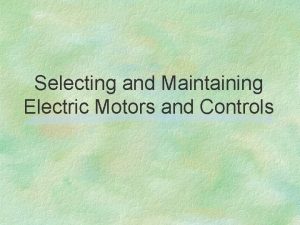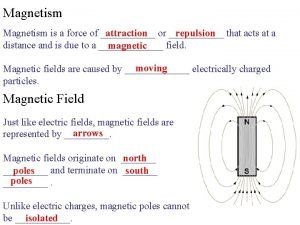Repulsion of quarkgluon strings and flow harmonics in

- Slides: 1

Repulsion of quark-gluon strings and flow harmonics in hadronic collisions Grigory Feofilov, Igor Altsybeev (SPb. SU) The MC model with string repulsion: Abstract Color flux tubes (quark-gluon strings), formed at early stages of hadron- hadron collision, may overlap in case of sufficiently high densities and interact by repelling or attracting each other, depending on the direction of the color fluxes [1]. Thus, in the hypothesis of repulsive interaction, in case of opposite color fluxes, strings may acquire, before the hadronization, the additional transverse boost. The last one is an efficient sum of all accounted string-string interactions. This produces additional transverse momenta to the particles formed in string decays over a wide range of rapidity, thus leading to modification of observables and to azimuthal asymmetry of two-particle correlations. In this report we discuss results of implementation of the Monte Carlo toy-model with the account of the string repulsion, and with an efficient string-string interaction radius. We show that the effect of string repulsion, as the main dynamic origin of the elliptic flow and of the higher harmonics, can describe the complicated structures observed in two-particle long-range correlation topology in proton-proton and nucleus-nucleus collisions at RHIC and at LHC. This work is supported by the Saint-Petersburg State University research grant 11. 38. 242. 2015. [1] V. A. Abramosvkii, E. V. Gedalin, E. G. Gurvich, and O. V. Kancheli, Pisma Zh. Eksp. Teor. Fiz. 47, No. 6, 281 -283 (25 March 1988). Model properties String β -boost distribution for different impact parameters. Initial Stages 2016 May 23 -27 Lisbon, Portugal central event Stage 1. Simulation of strings configuration § Nuclei: Pb 208, the Woods-Saxon radius is 6. 62 fm, a = 0. 546 fm § Inside each nucleon partons are distributed in transverse (xy) plane with 2 D-Gauss law, with σxy = 0. 4 fm. § The mean number of partons inside nucleons is dependent on a collision energy and is a model parameter. § Partons can interact and form a string, if the distance between partons in xy plane is less then some parton interaction distance dp. § There is a 3% probability for a string to be a "hard scattering” (simulation of jet-like structures). semicentral event § All other strings are considered to be "soft" and "long" in rapidity, occupying rapidity range y ∈ (− 4, 4). Stage 2. Repulsion of the strings § Strings have effective interaction radius Rstring § Strings overlapping leads to repulsion, string boost is ajusted to �βstring�≈ 0. 65 in central Pb-Pb collisions § Interaction between strings Stage 3. String hadronization § Each string breaks into quark-antiquark pairs in several places, forming a number of mesons (pions and ρ → ππ) § Transverse Lorentz boost βstring is applied for each particle Two-particle ∆η-∆φ correlations Initial configuration of quark-gluon strings could be transferred due to string-string interaction into the azimuthal flows. Two-particle correlation functions obtained in the toy model for peripheral (left), semi-central (middle) and central (right) events are shown in the Figure below for charged particles with p. T > 0. 15 Ge. V/c, with string effective interaction radius 2 fm. The pads in the Figure illustrate the onset of collectivity when passing from peripheral to central A-A collisions. In peripheral events, a structure along ∆φ is visible, which is due to the ρ0 decays into pions. More massive particles gain more p. T shift. harderning of spectrum for protons may be observed Harmonic decomposition of the Δφ projection of 2 PC for central events Left: Two-particle correlation function obtained in MC model in the most central Pb-Pb events for charged particles with p. T ∈ [3, 5] Ge. V/c. String effective interaction radius is 2 fm. Right: The harmonic decomposition of the azimuthal profile of the correlation function shown in the left pad. The solid red line shows the sum of the anisotropic flow Fourier coefficients v 1, v 2, v 3, v 4, and v 5 (dashed lines). Δφ projection of two-particle correlation function in Pb-Pb collisions by ALICE (PRL, 107, 032301, 2011) MC model results for harmonic coefficients obtained by fitting of the two-particle correlation functions from the simulated events with harmonics v 1 -v 4. Two values of the string interaction radius (1 and 2 fm) are explored. (centrality estimator ν = 2 Ncoll/Npart is used) Differential p. T-dependent flow Conclusions • A dynamic origin of the elliptic flow and of the higher components of two-particle angular correlations observed in nucleus- nucleus collisions can be explained in a qualitative way by the repulsion of interacting color flux tubes (strings). • The value of effective string interaction radius Rint∼ 2 fm provides qualitative description of elliptic and triangular flows in nucleus-nucleus collisions at RHIC and LHC energies. REFERENCES 1) “Mean transverse momenta correlations in hadron-hadron collisions in MC toy model with repulsing strings”, I. Altsybeev, AIP Conf. Proc. 1701 (2016) 2) “Constraints on the percolation model from anomalous centrality evolution of two-particle correlations in Au-Au collisions at √s. NN = 62 and 200 Ge. V”, I. Altsybeev, G. Feofilov and O. Kochebina, AIP Conf. Proc. 1701, 060011 (2016).

